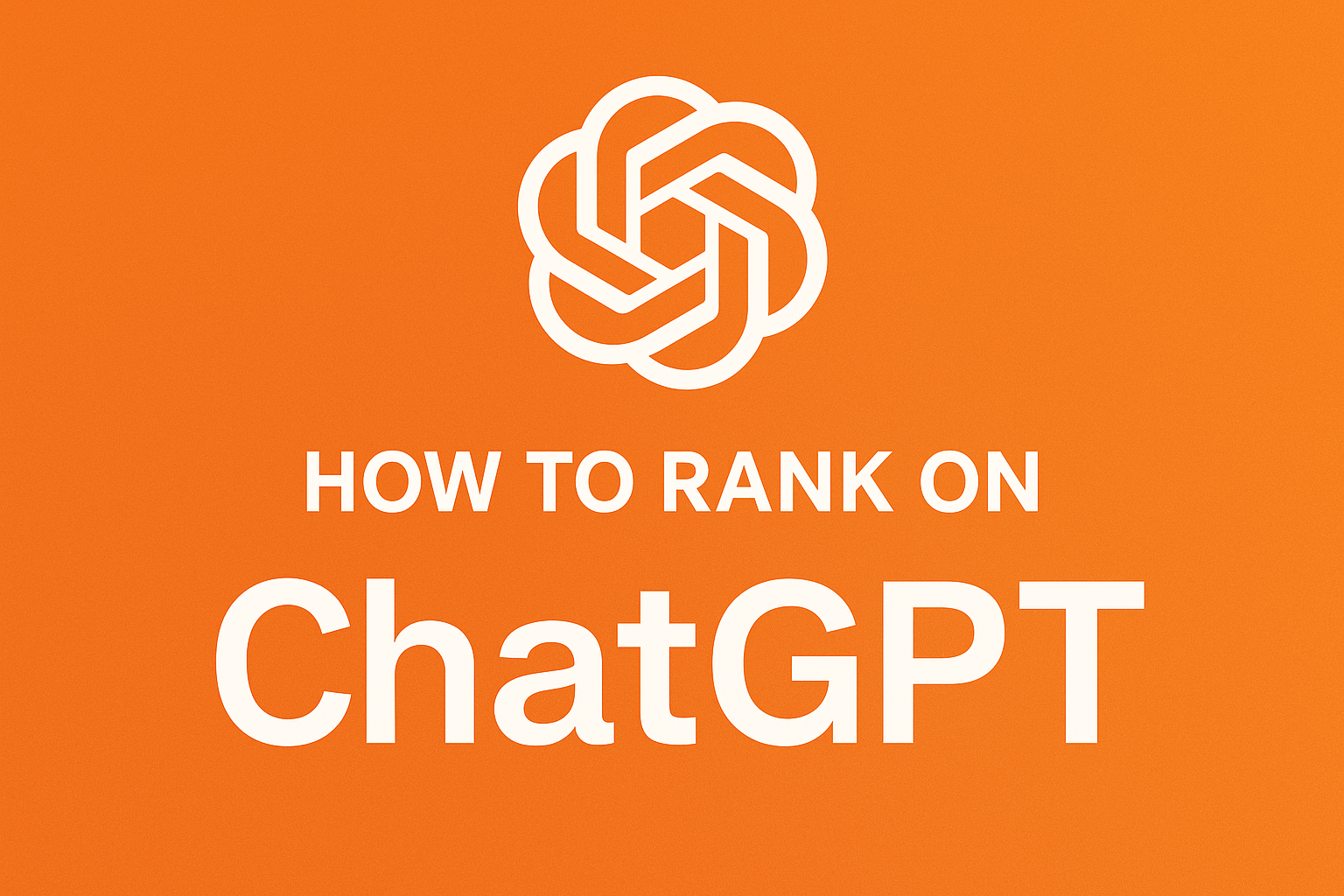Last Updated on 2 weeks ago by Hitakshi Parmar
People aren’t just searching on Google anymore. They’re asking AI tools like ChatGPT for advice, product picks, tutorials, and local recommendations. With millions of daily users, ChatGPT has become its own search engine, and that shift opens a new question for businesses:
How do you rank on ChatGPT?
If your website isn’t showing up in ChatGPT’s answers, you’re losing mindshare and potential customers. The good news is you can optimize your content specifically for AI. If you understand how ChatGPT pulls information, you can position your brand to appear more often.
This guide walks through how to rank in ChatGPT search, how to be ranked in ChatGPT more consistently, and what you need to do in 2025 and 2026 as AI-driven discovery becomes the new normal.
What ChatGPT SEO Really Means
ChatGPT SEO is the practice of making your content easy for ChatGPT to read, understand, summarize, and reference in its answers. It’s not the same as traditional SEO, but there’s overlap.
ChatGPT relies on two main sources:
- What it learned during training
- What it can fetch in real time through its browsing system, which uses Bing
So if you want to rank in ChatGPT search results, your content must be:
- Structured
- Trustworthy
- Indexed
- Easy to interpret
- Frequently updated
The more your site aligns with those signals, the more likely AI is to use it.
1. Write for Questions, Not Just Keywords
If you want to rank higher in ChatGPT, start with the questions people actually ask.
Instead of chasing broad keywords, structure your content around:
- How to rank in ChatGPT
- How to rank website in ChatGPT
- How to get ranked in ChatGPT
- How to rank on ChatGPT in 2025 and beyond
Use tools like Reddit, People Also Ask, and AnswerThePublic to uncover real queries. Then create sections that directly answer those questions in plain, straightforward language.
ChatGPT responds well to content that mirrors user intent.
2. Put the Answer Up Front
Don’t make readers dig. ChatGPT won’t.
If your main answer is buried halfway down the page, the model is less likely to use it. Open every article or section with a tight, direct explanation. Follow that with supporting context, examples, and data.
A simple flow works best:
- Answer
- Why it matters
- Details or steps
- Examples
This pattern helps you rank in ChatGPT search because AI prefers clean, clear information hierarchy.
3. Build Clean Structure With Clear Headings
Think of headings and subheadings as signposts for AI. They tell ChatGPT where the key ideas live.
Use:
- H1 for the main topic
- H2s for major points
- H3s for deeper breakdowns
Short paragraphs, readable formatting, and clean HTML help ChatGPT parse the page. Fix broken tags, remove cluttered code, and tighten your layout.
When your structure is clear, ChatGPT can summarize and reference your content more confidently.
4. Shift to Semantic SEO
To rank on ChatGPT in 2025 and 2026, you’ll need topic depth, not keyword stuffing.
Semantic SEO means covering the broader ecosystem around your topic. If you’re writing about ChatGPT ranking strategies, include related concepts like:
- Generative Engine Optimization
- NLP techniques
- E-E-A-T signals
- AI content quality standards
The richer the topical map, the easier it is for ChatGPT to understand and trust your site.
5. Make Sure Bing Can Index You
This step gets ignored constantly.
ChatGPT’s browsing uses Bing. So if Bing can’t access your site, neither can ChatGPT. That means you won’t rank in ChatGPT search results at all.
Check these:
- Submit your sitemap through Bing Webmaster Tools
- Allow Bing and GPTBot in robots.txt
- Fix crawl errors
- Improve page speed
- Ensure mobile compatibility
Technical visibility is half the battle.
6. Strengthen Brand Authority
AI models lean heavily on authority. If you want to be ranked in ChatGPT more often, you need signals that prove your site is trustworthy.
Build authority by:
- Capturing quality backlinks
- Contributing to reputable publications
- Earning mentions in news articles
- Getting listed on Crunchbase, Wikipedia, industry directories
- Maintaining consistent author bios
The more your brand shows up across the web, the more it gets embedded into AI models and real-time responses.
7. Add Schema Markup and Helpful FAQs
Schema markup is like giving AI a cheat sheet.
Add:
- FAQ schema
- HowTo schema
- Article schema
- Organization and Person schema
At the bottom of your content, include conversational FAQ sections that match how users talk to ChatGPT. Things like:
- How to rank higher in ChatGPT
- How to rank website in ChatGPT
- Why isn’t my content appearing in ChatGPT?
These questions help create direct answer pairs that AI can easily pull into its responses.
8. Refresh Content Regularly
Outdated content sinks fast in AI answers.
Update every few months:
- Stats
- Screenshots
- Examples
- Tools
- Links
- AI-related terminology
Fresh content performs better on Bing and gives ChatGPT a stronger reason to reference you.
9. Test Your Rankings Like a Researcher
If you want to know how to rank in ChatGPT search, you have to test it.
Run trial questions such as:
- Best SEO agency for ChatGPT ranking
- How to rank on ChatGPT in 2025
- How to be ranked in ChatGPT for competitive keywords
See who is appearing. Compare their structure, format, and coverage to yours. This helps you reverse-engineer what ChatGPT prefers.
Also track brand mentions using tools like Semrush, Brand24, and Mention.
10. Build Your Brand Like a Real Entity
AI rewards legitimacy.
To rank on ChatGPT in 2026 and beyond, build a recognizable digital footprint:
- Complete your Google and Bing business profiles
- Create detailed author pages
- Strengthen your About page
- Build citations across reputable directories
- Stay active on platforms that AI crawls
The more real you appear online, the more often AI models will treat your content as trustworthy.
Conclusion
If you’re wondering how to rank in ChatGPT, how to get ranked in ChatGPT answers, or how to rank a website in ChatGPT for future AI-driven searches, the path is clear: structure your content well, answer real questions upfront, build authority, maintain technical health, and update consistently.
Ranking on ChatGPT isn’t random. It’s the result of aligning your content with the way AI reads and interprets information.
If you want expert help refining your strategy, Allunique SEO Agency can guide you through AI-first optimization and prepare your brand for the next generation of search.
FAQs
- Is there a way to track whether my website is being used in ChatGPT answers?
There isn’t an official analytics tool yet, but you can still get signals. Run test prompts related to how to rank in ChatGPT, check Bing rankings, and monitor brand mentions. As your visibility improves, you’ll notice your content appearing more often, which means you’re moving closer to how to get ranked in ChatGPT consistently.
- Does content length affect how to rank higher in ChatGPT?
Yes, but structure matters more than word count. ChatGPT prefers clean, well-organized content. A shorter guide with strong formatting can outperform a long, messy article. If you’re focused on how to rank higher in ChatGPT or how to rank in ChatGPT search results, prioritize clarity over length.
- Can a new website still learn how to rank website in ChatGPT?
Absolutely. New domains can still get traction if they focus on question-based content, schema markup, and strong topic clusters. Even without massive authority, you can still work toward how to rank website in ChatGPT by covering topics deeply and earning a few credible links.
- What type of content performs best for how to be ranked in ChatGPT?
ChatGPT favors content that gives direct answers. Step-by-step guides, checklists, and clear comparisons usually perform best. If your goal is to be ranked in ChatGPT more often, write content that mirrors how users ask questions and delivers quick clarity.
- Is there anything special I should do to learn how to rank on ChatGPT in 2025 or how to rank on ChatGPT in 2026?
Yes. AI search is shifting toward credibility and freshness. Keep your content updated, strengthen author profiles, use schema, and build entity authority. If you want to stay ahead with how to rank on ChatGPT in 2025 or prepare early for how to rank on ChatGPT in 2026, focus on being a trusted, verifiable source.




